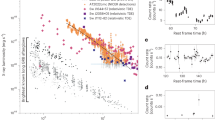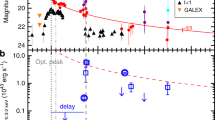Abstract
Supermassive black holes have powerful gravitational fields with strong gradients that can destroy stars that get too close1,2, producing a bright flare in ultraviolet and X-ray spectral regions from stellar debris that forms an accretion disk around the black hole3,4,5,6,7. The aftermath of this process may have been seen several times over the past two decades in the form of sparsely sampled, slowly fading emission from distant galaxies8,9,10,11,12,13,14, but the onset of the stellar disruption event has not hitherto been observed. Here we report observations of a bright X-ray flare from the extragalactic transient Swift J164449.3+573451. This source increased in brightness in the X-ray band by a factor of at least 10,000 since 1990 and by a factor of at least 100 since early 2010. We conclude that we have captured the onset of relativistic jet activity from a supermassive black hole. A companion paper15 comes to similar conclusions on the basis of radio observations. This event is probably due to the tidal disruption of a star falling into a supermassive black hole, but the detailed behaviour differs from current theoretical models of such events.
This is a preview of subscription content, access via your institution
Access options
Subscribe to this journal
Receive 51 print issues and online access
$199.00 per year
only $3.90 per issue
Buy this article
- Purchase on Springer Link
- Instant access to full article PDF
Prices may be subject to local taxes which are calculated during checkout



Similar content being viewed by others
References
Rees, M. J. Tidal disruption of stars by black holes of 106–108 solar masses in nearby galaxies. Nature 333, 523–528 (1988)
Evans, C. R. & Kochanek, C. S. The tidal disruption of a star by a massive black hole. Astrophys. J. 346, L13–L16 (1989)
Ulmer, A. Flares from the tidal disruption of stars by massive black holes. Astrophys. J. 514, 180–187 (1999)
Bogdanovic´, T., Eracleous, M., Mahadevan, S., Sigurdsson, S. & Laguna, P. Tidal disruption of a star by a black hole: observational signature. Astrophys. J. 610, 707–721 (2004)
Guillochon, J., Ramirez-Ruiz, E., Rosswog, S. & Kasen, D. Three-dimensional simulations of tidally disrupted solar-type stars and the observational signatures of shock breakout. Astrophys. J. 705, 844–853 (2009)
Strubbe, L. E. & Quataert, E. Optical flares from the tidal disruption of stars by massive black holes. Mon. Not. R. Astron. Soc. 400, 2070–2084 (2009)
Brassart, M. & Luminet, J. Relativistic tidal compressions of a star by a massive black hole. Astron. Astrophys. 511, A80 (2010)
Brandt, W. N., Pounds, K. A. & Fink, H. The unusual X-ray and optical properties of the ultrasoft active galactic nucleus Zwicky 159.034 (RE J1237+264). Mon. Not. R. Astron. Soc. 273, L47–L52 (1995)
Komossa, S. & Bade, N. The giant X-ray outbursts in NGC 5905 and IC 3599: Follow-up observations and outburst scenarios. Astron. Astrophys. 343, 775–787 (1999)
Donley, J. L., Brandt, W. N., Eracleous, M. & Boller, T. Large-amplitude X-ray outbursts from galactic nuclei: a systematic survey using ROSAT archival data. Astron. J. 124, 1308–1321 (2002)
Esquej, P. et al. Candidate tidal disruption events from the XMM-Newton slew survey. Astron. Astrophys. 462, L49–L52 (2007)
Gezari, S. et al. UV/optical detections of candidate tidal disruption events by GALEX and CFHTLS. Astrophys. J. 676, 944–969 (2008)
Gezari, S. et al. Luminous thermal flares from quiescent supermassive black holes. Astrophys. J. 698, 1367–1379 (2009)
Maksym, W. P., Ulmer, M. P. & Eracleous, M. A tidal disruption flare in A1689 from an archival X-ray survey of galaxy clusters. Astrophys. J. 722, 1035–1050 (2010)
Zauderer, B. A. et al. The birth of a relativistic outflow in the unusual γ-ray transient Swift J164449.3+573451. Nature 10.1038/nature10366 (this issue).
Gehrels, N. et al. The Swift gamma-ray burst mission. Astrophys. J. 611, 1005–1020 (2004)
Barthelmy, S. D. et al. The Burst Alert Telescope (BAT) on the SWIFT Midex mission. Space Sci. Rev. 120, 143–164 (2005)
Burrows, D. N. et al. The Swift X-Ray Telescope. Space Sci. Rev. 120, 165–195 (2005)
Goad, M. R. et al. Accurate early positions for Swift GRBs: enhancing X-ray positions with UVOT astrometry. Astron. Astrophys. 476, 1401–1409 (2007)
Evans, P. A. et al. Methods and results of an automatic analysis of a complete sample of Swift-XRT observations of GRBs. Mon. Not. R. Astron. Soc. 397, 1177–1201 (2009)
Levan, A. J. et al. An extremely luminous panchromatic outburst from the nucleus of a distant galaxy. Science 333, 199–202 (2011)
Romano, P. et al. Two years of monitoring supergiant fast X-ray transients with Swift. Mon. Not. R. Astron. Soc. 410, 1825–1836 (2011)
Bohlin, R. C., Savage, B. D. & Drake, J. F. A survey of interstellar H I from Lα absorption measurements. II. Astrophys. J. 224, 132–142 (1978)
Grindlay, J. E. in X-ray Timing 2003: Rossi and Beyond (eds Kaaret, P., Lamb, F. K. & Swank, J. H. ) 413–422 (Am. Inst. Phys. Conf. Ser., Vol. 714, 2004)
Kraft, R. P., Burrows, D. N. & Nousek, J. A. Determination of confidence limits for experiments with low numbers of counts. Astrophys. J. 374, 344–355 (1991)
Lodato, G. & Rossi, E. M. Multiband light curves of tidal disruption events. Mon. Not. R. Astron. Soc. 410, 359–367 (2011)
Phinney, E. S. in The Center of the Galaxy (ed. Morris, M. ) 543–553 (IAU Symp., Vol. 136, 1989)
Lodato, G., King, A. R. & Pringle, J. E. Stellar disruption by a supermassive black hole: is the light curve really proportional to t–5/3? Mon. Not. R. Astron. Soc. 392, 332–340 (2009)
Aliu, E. et al. VERITAS observations of the unusual extragalactic transient Swift J164449.3+573451. Astrophys. J. (in the press); preprint at http://arXiv.org/abs/1107.1738
Ghisellini, G. & Tavecchio, F. Canonical high-power blazars. Mon. Not. R. Astron. Soc. 397, 985–1002 (2009)
Acknowledgements
We acknowledge support from the following funding agencies: NASA, NSF and DOE (US); the UK Space Agency; ASI, INAF and INFN (Italy); the Autonomous Region of Sardinia; MEXT, KEK and JAXA (Japan); CRI/NRF/MEST (Korea); NSC and Academia Sinica (Taiwan); CEA/Irfu, IN2P3/CNRS and CNES (France); and the K. A. Wallenberg Foundation, the Swedish Research Council and the National Space Board (Sweden). We thank the Swift, Fermi and MAXI operation teams; and we thank A. Read for help with the most recent XMM slew data. We acknowledge the contribution of pre-publication upper limits by the VERITAS Collaboration. Finally, we acknowledge the use of public data from the Swift and Fermi data archives (http://heasarc.nasa.gov/docs/swift/archive/ and http://fermi.gsfc.nasa.gov/ssc/, respectively), as well as data supplied by the UK Swift Science Data Centre at the University of Leicester. E.T. is a NASA Postdoctoral Fellow.
Author information
Authors and Affiliations
Contributions
D.N.B., J.A.K. and M.E. composed the text, using inputs from the other co-authors. Theoretical interpretation was provided by G.G., B.Z., M.E. and P.M., with contributions by A.D.F., S. Campana and N.G.; J.A.K., V.M., K.L.P., J.P.O., P.R., S. Campana, A.P.B., V.D’E., P.E., P.A.E. and G.I. processed and analysed the Swift XRT data. T.S., J.R.C. and H.A.K. processed and analysed the Swift BAT data. Swift UVOT data were processed and analysed by A.A.B., M.M.C., S.T.H. and F.E.M. Ground-based optical/NIR data were obtained with the TNG, BOAO, LOAO, CFHT, UKIRT and Maidanak Observatory telescopes, and were provided, reduced and analysed by S. Covino, P.D’A., D.F., K.Y.H., M.I., H.D.J., Y.J., Y.-B.J., J.H.K., W.-K.P., H.-I.S., G.T., Y. Urata and L.A.A. Fermi LAT data analysis was performed by R.C., N.O., J.S.P. and E.T.; K.H., N.K., H.N., M.S., Y. Ueda and R.U. processed and analysed the MAXI data. A.D.F. provided liaison with the VERITAS Collaboration. J.M.G. and P.G. provided analysis of ROSAT archival data, and J.P.O. provided analysis of archival XMM data. All authors discussed the results and commented on the manuscript.
Corresponding author
Ethics declarations
Competing interests
The authors declare no competing financial interests.
Additional information
Swift data are available from the NASA HEASARC (http://swift.gsfc.nasa.gov/docs/swift/archive/) or from mirror sites in the UK (http://www.swift.ac.uk/swift_portal/archive.php) and Italy (http://swift.asdc.asi.it/).
Supplementary information
Supplementary Information
The file contains Supplementary Observations and Data Analysis, a Supplementary Discussion (see Contents list for full details), Supplementary Tables 1-13, Supplementary Figures 1-17 with legends and additional references. (PDF 3538 kb)
Supplementary Data
The file shows Supplementary Dataset 1 (light curve shown in Figure 2). (TXT 343 kb)
Rights and permissions
About this article
Cite this article
Burrows, D., Kennea, J., Ghisellini, G. et al. Relativistic jet activity from the tidal disruption of a star by a massive black hole. Nature 476, 421–424 (2011). https://doi.org/10.1038/nature10374
Received:
Accepted:
Published:
Issue Date:
DOI: https://doi.org/10.1038/nature10374
This article is cited by
-
Minutes-duration optical flares with supernova luminosities
Nature (2023)
-
High-energy neutrino transients and the future of multi-messenger astronomy
Nature Reviews Physics (2022)
-
A 62-minute orbital period black widow binary in a wide hierarchical triple
Nature (2022)
-
A very luminous jet from the disruption of a star by a massive black hole
Nature (2022)
Comments
By submitting a comment you agree to abide by our Terms and Community Guidelines. If you find something abusive or that does not comply with our terms or guidelines please flag it as inappropriate.



